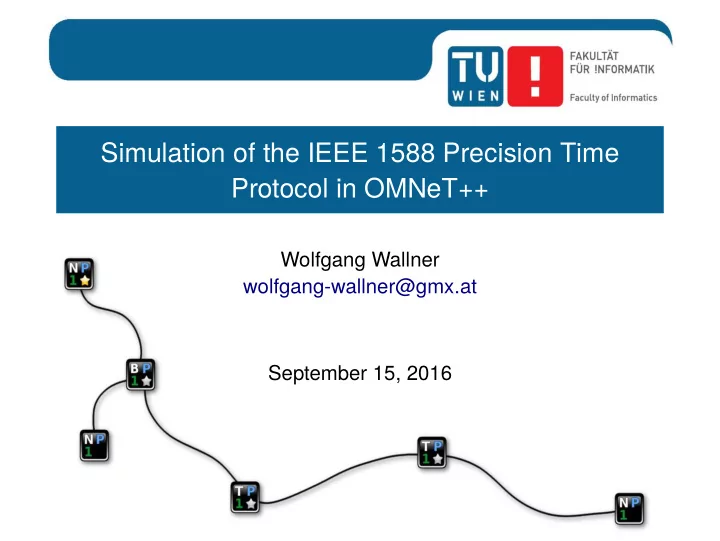

References I John C. Eidson Measurement, Control, and Communication Using IEEE 1588 Springer, 2006 Georg Gaderer, et al An Oscillator Model for High-Precision Synchronization Protocol Discrete Event Simulation Proceedings of the 39th Annual Precise Time and Time Interval Meeting, 2007 IEEE Std 1139-2008 IEEE Standard Definitions of Physical Quantities for Fundamental Frequency and Time Metrology - Random Instabilities 2009
References II N. Jeremy Kasdin and Todd Walter Discrete Simulation of Power Law noise Proceedings of the 1992 IEEE Frequency Control Symposium, 1992 William J. Riley Handbook of Frequency Stability Analysis NIST Special Publication 1065, 2008 Enrico Rubiola The Leeson effect - Phase noise in quasilinear oscillators ArXiv Physics e-prints, 2005 W. Wallner Simulation of Time-synchronized Networks using IEEE 1588-2008 Master’s thesis, Faculty of Informatics, Vienna University of Technology, 2016
Dropped Slides Dropped Slides
Motivation PTP: Compromise between cost and precision
Motivation PTP: Compromise between cost and precision
Motivation PTP: Compromise between cost and precision
Motivation PTP: Compromise between cost and precision
Problem statement Reminder: Any simulation is just as good as its models. Possible risks of simulation include: ◮ Too naive clock model → false positives ◮ Clumsy control loop → false negatives
Frequency Stability Analysis - Intro ◮ We need to justify the stability of clocks ◮ This discipline is called Frequency Stability Analysis (FSA) ◮ Literature: ◮ Handbook of Frequency Stability Analysis [5] ◮ IEEE 1139 [3] (Standard definitions for random instabilities)
Clock Noise: Description Two important measures for description of noise: S y ( f ) Power Spectral Density (PSD) One-sided PSD of y ( t ) Useful for frequency domain analysis
Clock Noise: Description Two important measures for description of noise: S y ( f ) Power Spectral Density (PSD) One-sided PSD of y ( t ) Useful for frequency domain analysis σ 2 y ( τ ) Allan Variance (AVAR) Special variance to measure stabilty of clocks Useful for time domain analysis
Powerlaw Noise I Random noise in oscillators has a special PSD shape : S y ( f ) ∝ f α Definition This is called Powerlaw Noise (PLN)
Powerlaw Noise II Special cases for α : ◮ 2 WPM White Phase Modulation ◮ 1 FPM Flicker Phase Modulation ◮ 0 WFM White Frequency Modulation ◮ -1 FFM Flicker Frequency Modulation ◮ -2 RW Random Walk
Powerlaw Noise examples
Allan Variance Allan Variance ◮ Problem: standard variance does not converge
Allan Variance Allan Variance ◮ Problem: standard variance does not converge ◮ Alternative: Allan Variance (AVAR)
Allan Variance Allan Variance ◮ Problem: standard variance does not converge ◮ Alternative: Allan Variance (AVAR) ◮ Equally widespread: Allan Deviation (ADEV)
Allan Variance Allan Variance ◮ Problem: standard variance does not converge ◮ Alternative: Allan Variance (AVAR) ◮ Equally widespread: Allan Deviation (ADEV) ◮ Example:
Relationship AVAR/PSD I PLNs have characteristic AVAR: Image was taken from [6].
Relationship AVAR/PSD II Table B.2 of IEEE 1139[3]: σ 2 PLN S y ( f ) y ( τ ) h − 2 · f − 2 A · h − 2 · τ 1 RW h − 1 · f − 1 B · h − 1 · τ 0 FFM h 0 · f 0 C · h 0 · τ − 1 WFM h 1 · f 1 D · h 1 · τ − 2 FPM h 2 · f 2 E · h 2 · τ − 2 WPM ◮ A, B and C are constants ◮ D and E depend on certain parameters
PTP - Timestamp modes Different timestamp modes: ◮ 1-step clocks ◮ 2-step clocks
PTP - Timestamp modes Different timestamp modes: ◮ 1-step clocks ◮ Capable of timestamping outgoing frames on-the-fly ◮ Needs explicit hardware support ◮ 2-step clocks
PTP - Timestamp modes Different timestamp modes: ◮ 1-step clocks ◮ Capable of timestamping outgoing frames on-the-fly ◮ Needs explicit hardware support ◮ 2-step clocks ◮ Not capable to timestamp on-the-fly ◮ Use FollowUp messages
PTP - State machine 3 non-transient states: ◮ MASTER ◮ SLAVE ◮ PASSIVE
PTP - Best Master Clock algorithm ◮ Clocks decide periodically about port states ◮ Next port state depends on ◮ received Announce messages ◮ timeouts ◮ synchronization errors ◮ ... ◮ Best Master Clock (BMC) is eventually consistent ◮ BMC results in a forest
PTP - Simple BMC example I ◮ At first, all nodes start in LISTENING
PTP - Simple BMC example II ◮ They see an idle PTP network, and try to become MASTER
PTP - Simple BMC example III ◮ As the nodes start to see Announce messages, some ports change to SLAVE
PTP - Simple BMC example IV ◮ Final hierarchy
BMC example: rings ◮ Example network with 1 good clock ◮ Passive states break rings
BMC example: 2 excellent clocks ◮ Example network 2 excellent clocks ◮ Passive states divide network
PTP - Synchronization principle Two tasks: ◮ Timestamp distribution ◮ Delay estimation
PTP - Clock types I Ordinary Clock (OC) ◮ 1 port ◮ typical end node
PTP - Clock types II Boundary Clock (BC) ◮ multiple ports ◮ otherwise similar to OC
PTP - Clock types III Transparent Clock (TC) ◮ multiple ports ◮ tries to not influence the PTP network ◮ residence time correction ◮ introduced in IEEE 1588-2008
PTP - Delay mechanisms I ◮ End-to-End (E2E) ◮ Peer-to-Peer (P2P)
PTP - Delay mechanisms II ◮ E2E: Slave measures and corrects full distance ◮ P2P: Each nodes measures and corrects small part ◮ Advantages E2E: ◮ Expected precision ◮ Advantages P2P: ◮ Reduced overhead ◮ Fast reaction on path change
Recommend
More recommend